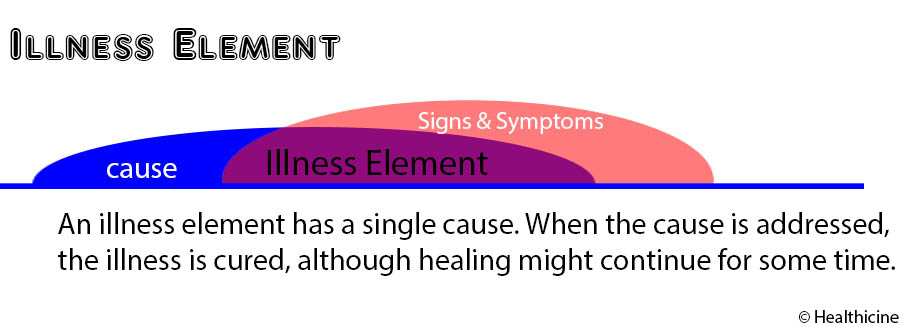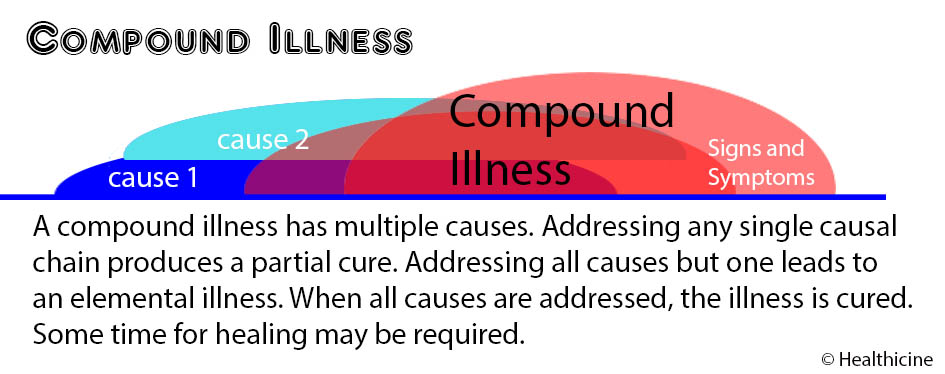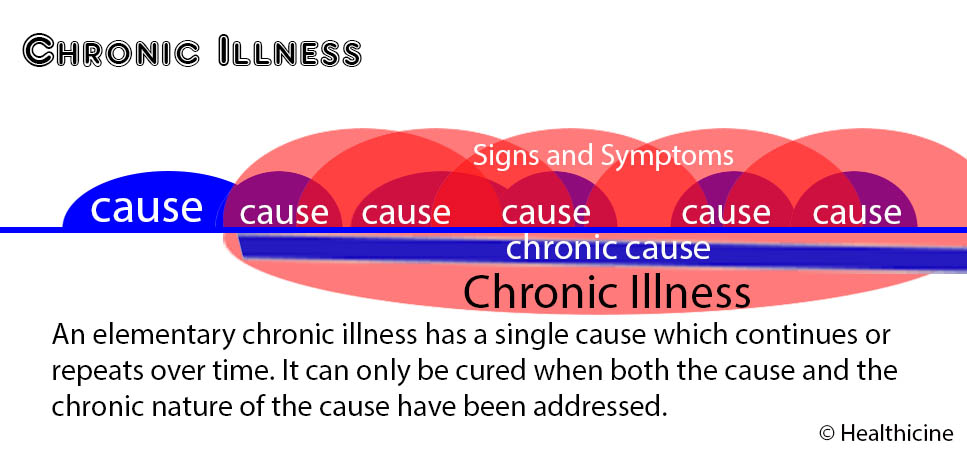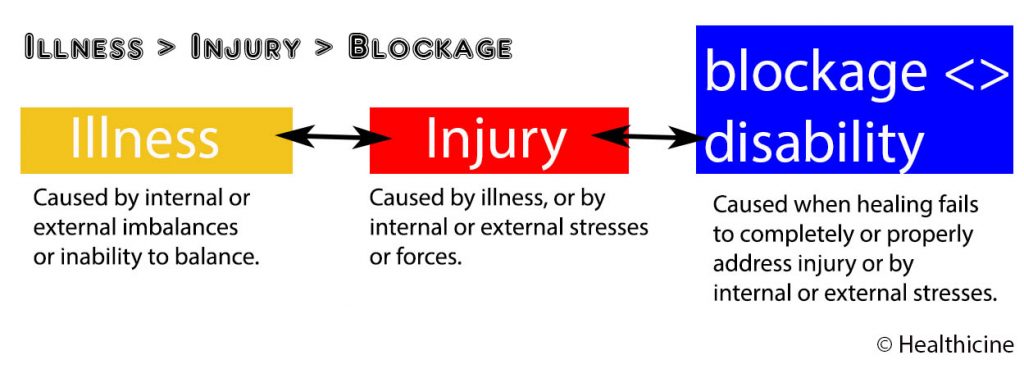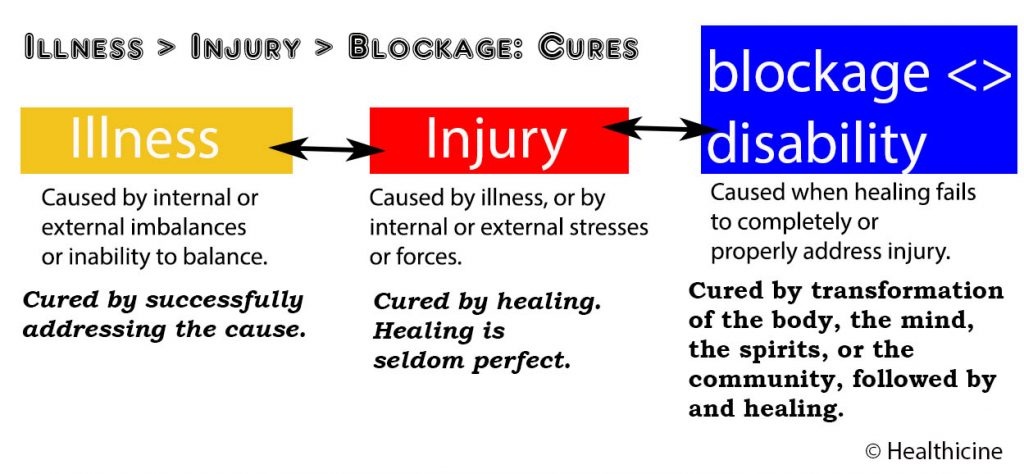“We all labour against our own cure, for death is the cure for all diseases.” Thomas Browne
Cures are miracles. Anyone who can cure, is eligible for sainthood. Such is the mystique of cures and curing. But, anyone who claims to cure any disease or medical condition is banished, treated more like the devil, or a ‘quack’ who is promoting ‘pseudo-science’. No self-respecting doctor would claim to cure. Training for nurses and other medical workers often advises “never use the word ‘cure“. Cures are considered impossible, or at least very unlikely, suspicious even when they occur.
In truth, cures are commonplace. So common that many cures are invisible. Our health easily cures the common cold, the flu, and measles, given a bit of time, while modern medicine claims them to be incurable. Cuts and bruises, large and small, are healed by nature – no doctor can cure them. Many disabilities, perhaps they should have been named ‘inabilities’ are cured by a physical, mental, spiritual, or community jolt of reality. If you believe you cannot be cured, you are disabled. In some cases, when you think you can, and try, your disability is converted to an inability, which is then cured. These cures, like most cures do not come from medicines, so they are ignored or dismissed as ‘anecdotes’ and placebo effects, by the students, practitioners, and scientists of medicine, and also by medicine marketers and insurance companies.
Every cure is an anecdote. Every illness is a unique story with a cause, a course, and a conclusion.
If cures were not so common, we would all die at an early age. Yet cures remain a mystery. We believe cures are few and far between, impossible, even as we are surrounded by them.
It’s time to open our eyes to a simple, clear understanding of cure.
Do not believe in miracle cures. A miracle cure is a failure to understand. Belief in miracle cures and in placebo effects and placebo cures only facilitates failure to study, failure to learn, failure to understand. When the cure of the illness is not understood, it cannot be intentionally repeated. Intentional cures begin with understanding, with study, not by ignoring, not with ignorance.
There are currently many definitions and meanings of the word ‘cure’. Dictionaries define, agree, and disagree silently about cure, cures, cured, and incurable. Medical dictionaries and reference books often abstain from making any statements about cure – while simultaneously claiming that many diseases, and all chronic diseases, are incurable. A cure brings an end to the illness. A cure addresses the cause. A treatment addresses the signs and symptoms of the illness – but the illness is not cured. A treatment cure is a symptom treatment. This article is about cures, real cures.
There are many different definitions of illness, disease, medical condition and disability – and little consistency in the use of terms by different authors and publications. In healthicine, an illness is a negative medical condition with a cause. An illness is cured, by addressing the cause. Treating the symptoms, without addressing the cause, will not end the illness, although sometimes treating symptoms aids the health of the patient to bring about a cure.
Curing Illness Elements
Cures can be simple, or compound, because illness can be simple or compound. Cure is simple when the illness is simple. Each illness element has a simple cause. The cure is to address the cause. A person suffering from a dietary deficiency of Vitamin C, causing scurvy, is cured by changing to a diet that contains sufficient Vitamin C. A person suffering from arsenic toxicity, is cured when they stop consuming foods that contain arsenic. Of course, in both cases, healing is required to complete the cure. These cures, like many cures, are so simple that they are ignored, dismissed, as if they are not a ‘real cures‘, because real cures are impossible to understand. Nonsense.
Simple cures are simple. Every illness has a cause. Every cure opposes the cause. The only cure is to oppose the cause.
Illness is simple. Illnesses can be complex. Every ’cause’ might also have a cause. Which is the key cause? Which cause is the root cause? There are no root causes. A key cause is any cause that leads to a cure when addressed, when the cause is opposed. A simple illness, a simple illness element, has a single cause, a single chain of causes. The longer the chain, the more complex is the simple illness.
A compound illness is an illness with multiple causes, with multiple chains of causes. A compound illness consists of two or more simple illnesses.
We simplify cures, first, by simplifying each illness to elemental illnesses. By breaking compound illnesses apart, to understand the simple illnesses inside. Then we address the single causes of the elemental illnesses, one at a time. It seems too simple. It is simple, because we made the effort to simplify it. It’s simple in theory. We need to change the practice of medicine to match the simple theory of cause.
Many cases of diseases are made up of complex and compound illness elements. When we treat these diseases, it’s too easy to resort to treating symptoms, ignoring causes. This approach is often seen as ‘successful’ by the patient, the doctor, medical science, and medical insurance providers, even as it fails to cure. This leads, predictably, to more complexities, often making the individual illness elements more difficult to cure. Over time, the approach of treating symptoms leads to a lack of faith in cure, even as we are surrounded by cures.
This is the state of medicine today:
Physicians of the utmost fame, were called at once; but when they came
They answered as they took their fees, ‘There is no cure for this disease.’ Hilaire Belloc
We will find cures, only when we look for cures, only when we pay for cures. Today, if you cure your disease, your medical insurance will not pay. Medical insurance pays for treatments, not for cures. They recognize that most cures do not come from medicines.
There are no incurable illnesses. Modern medicine, makes the same mistake as the Oxford Dictionary, defining ‘incurable‘ as ‘incapable of being cured by medicine or medical skill‘, forgetting that most illnesses are not cured by medicine, nor medical skill, but by health. It is not possible to prove that an illness cannot be cured, without calling it a disability. A disability is not an illness. It is sometimes possible to prove that a disability was an illness, by curing which converts it to an illness.
“Life is an incurable disease.“ Abraham Cowley.
– Illness, on the other hand, is curable, by definition
There is a simple, clear, complete definition of cure, from a healthicine perspective. We need a useful, medical, scientific definition of cure, understood by all parties in the medical realm.
The intent of this post is to cure illness.
“The cure for this ill is not to sit still,
Or frowst with a book by the fire;
But to take a large hoe and a shovel also,
And dig till you gently perspire.” Rudyard Kipling
Definitions of Cure
==================
Note: This post is part of work in progress. The current, up to date healthicine definition of ‘cure’ can be found here.
Cure: n. A cure is the end of an illness. ( Reference: 1)
Cure: v. To bring about the end of an illness by addressing the cause, by opposing the cause.
Illness: n. An illness is a negative condition, consisting of a cause, which might be in the body, the mind, the spirit, or the community of the patient, and the consequences, signs and symptoms, which affect the body, the mind, the spirits and the communities of the patient.
Cures: There are four distinct types of cures: curing, healing, transformation, and prevention.
============
Types of Cures
1. Curing: bringing about the end of an active illness in the body, the mind, the spirits, or the community, by addressing the cause, by opposing the cause. An illness is the intersection of a cause and negative consequences, signs and symptoms of illness. It is cured when the cause has been successfully addressed. Corollary: The cause of an active illness has been successfully addressed when the illness is cured.
A partial cure occurs when the cause of an illness is partially addressed, or when a single cause of a compound illness, with multiple causes, is addressed.
A temporary cure occurs when the cause of an illness is temporarily addressed. Temporary cures lead to chronic illness when the cycle is repeating.
While an illness is not cured, it creates injuries.
2. Healing is an ongoing curative process that is present before, during, and after the illness. (Reference 2, 3, 4). Injuries are healed. An injury might come from an illness, or from an external event. Healing is seldom perfect, and imperfect healing can lead to blockage, which can only be cured by a transformation, or an incurable disability.
3. Transformation: Removing, and thus curing, physical (body), mental (mind), spiritual (spirits), and communal (community) blockage or disability. (Reference 4) Surgical cures are transformations. Often, less severe transformations, physical changes to body, or changes to mental, spiritual or community states are sufficient. Removal of blockage often necessitates healing. Not all blockages can be cured – a blockage that cannot be cured is a disability.
4. Preventative cures address causes before illness can arise. Preventative cures address risk, and entail risks. We must always balance the risk of illness with the risk of prevention. Most cases of illness are minor, not serious.
Notes:
The definition presented here is a healthicine definition of cure. It is designed to present a comprehensive, cohesive definition of cure for all types of illnesses. It is based on the concept that a cure is the end of an illness. Treatments for signs and symptoms of illness, that do not address cause, are symptomicines or symptomicine treatments, not cures. Symptomicine treatments often lead to new illnesses, often mistakenly called side-effects. They are not effects of the illness, not effects of a cure, they are effects of a treatment that fails to cure, often effects of a treatment that makes no attempt to cure.
There are many definitions of ‘cure’ to be found in standard dictionaries. Dictionaries must document all usage, including historical usage, not just medical or scientific usage. However, current dictionaries make no distinction between cures and symptom treatments. There is currently no ‘useful’ medical view of cure, that is recognized and accepted by the many practices of medicine to be found in any medical reference. Many medical dictionaries and medical reference texts do not define cure at all, and actively avoid use of the word cure.
Types of Illness
To understand cure, we need to understand the concepts of illness. An illness is not a disease. Every illness is a specific, single case. Every illness is a story, an anecdote. Every cure is an anecdote.
Illness is Invisible
Illness is invisible. Every illness has a cause. An illness is the intersection of a cause and the consequences. We might see or know the cause. We might see or feel the consequences, the signs and symptoms. We can’t actually see the illness. Neither cause nor consequences alone are the illness. Illness only exists when cause and consequences are linked.
Illness is a Judgement
Illness is a judgement, a negative judgement. Sometimes, perhaps often, the illness is clearly understood and defined, and the patient, the doctor, and the community agree that an illness is present, even which cause is active. Sometimes, it is not so clear. Sometimes the patient believes there is an illness, but the doctor does not. Sometimes, the doctor believes there is an illness, but the patient does not. This can be natural, even healthy, because of the natural integration and gradation between healthiness and illness. Illness can sometimes appear due to a negative judgement – by the patient or an external person. Sometimes it can disappear due to a contrary, positive judgement. This too can be natural and healthy.
Illness Element
An illness element, or elemental illness is the intersection of a single cause and negative consequences, the signs and symptoms of illness, from that cause. Illness elements are cured by addressing the elementary cause. We can identify a chain of causes, by asking both “what is the cause of this cause”, and “what is the consequence of this cause”. Often, it is also important to ask “How is the patient benefiting from this cause?” – this question is best answered by the patient in most cases. The complexity of an illness depends on how many causes are in the chain, and how their be linked to healthiness as well as illness.
If the chain of causes is truly linked, then addressing any single cause in the chain will produce a cure. Most cures can only cure a single illness element.
A compound illness consists of a group of elementary illnesses with similar or overlapping signs and symptoms. A compound illness, by definition, has multiple independent causes, more than one causal chain. It is compound with respect to cause and also with respect to being cured. Any case of a disease that has multiple independent causes is a compound illness.
Compound illnesses are cured one illness element at a time, by addressing each of the illness elements, each of the causal chains. Curing an illness element that is part of a compound illness is a partial cure, a complete cure of the illness element. Curing an entire compound illness requires curing each illness element. Cure sequencing might be an important factor to consider, because illnesses caused by illness might not be cured out of sequence.
A chronic illness is an illness with chronic causes. A simple chronic illness has a single chronic cause, or a single chain of chronic causes. It can only be cured by addressing the chronic nature of the cause. Every chronic illness is also a compound illness, because in its simplest form, it consists of a series of elemental illnesses, and the chronic illness as well. It requires two actions to cure, one to address the cause, and another to address its chronic nature.
Any illness can be chronic. The requirement for a chronic illness is a chronic cause – if the cause is chronic, the illness will be chronic. Injury illnesses can be chronic, if the activities causing the illness are chronic. Blockages illnesses are chronic by nature, existing until the blockage is transformed.
Remission is often only a remission of symptoms, brought about by symptomicine treatments. Remissions can also occur in chronic illnesses, when a single causal instance is cured, or when the chronic cause is diminished or the period between causes is long enough for some recovery.
A chronic compound illness is a compound illness with chronic causes. It can only be totally cured by addressing each of the chronic causes and their chronic nature. Many chronic diseases are compound chronic illness.
Chronic illnesses can emerge when we fail, or give up our attempts to cure, when we only use medicines that treat symptoms – symptomicines. In addition, medicines that treat symptoms often have side effects. Symptomicines designed to treat chronic illnesses are ‘chronic’ in nature, intended to be taken over extended periods of time. These side effects become new iatrogenic chronic illnesses, caused by chronic medication.
Progression of Illness
This diagram presents the transitions from illness, to injury, to blockage, to disability.
Illness can lead to injury, and injury can cause illness. Injury can lead to blockage – and a blockage can cause injury. A blockage that is incurable is a disability. When a disability is cured, we see that it as a blockage in the past.
A cure is the END of an illness. When a cure is accomplished, medicines that were used to treat symptoms of the illness are no longer needed. One goal cures is to remove our dependence on medicines.
- A cure of an active illness, an illness with an active cause, comes about when the cause is addressed, and thus the activity of the illness is stopped.
- Healing damage caused by injury or illness is a curative process that comes to an end when healing is completed. When healing is completed, the medicines used to treat symptoms of the illness are no longer needed.
- Transformation cures blockage illnesses. Transformation often creates injury and thus requires healing to complete the process.
This diagram completes the transitions from illness to injury to blockage and disability, by adding the techniques to cure each condition.
Illnesses are cured by addressing the cause. Injuries are cured by healing. Blockages are cured by transformation.
Cures come from Health
Who cures? Cures are always accomplished by the health of the patient, although a cure might be aided by others.
- A cure addresses an active illness, an illness with an active cause. Active causes can come from external life forms (parasites), or the patient’s life activities. Medicines can sometimes address a parasitic illnesses, but no medicine can change the activities of the patient. Only the patient can cure an illness that is not caused by a parasite. Many parasitic illnesses are cured naturally, by the health of the patient, often before they are consciously noticed as illnesses. Even chronic parasitic illnesses might be cured by health, without conscious awareness of the patient or medical staff, if the chronic nature of the cause is addressed.
- Healing is accomplished by the healthy body, mind, spirit and community of the patient. No external person or doctor can ‘heal’ the damage of an injury. Healing can be aided by healthiness, by proper diet, physical, mental, spiritual, and community exercise and rest. Healing is part of growth, which is always active, even when no illness is active. The immune system is a healing system and also a powerful curing system.
- Transformation can come about when the patient becomes aware of the blockage that is the disability and changes themselves. In some cases, a change can come about without awareness of the blockage. Transformation can also be induced with the help of an external person by physical, mental, spiritual, or community manipulation to identify, remove, and cure the blockage. Disabilities and blockages that persist over time can be chronic causes causing chronic diseases. If a blockage cannot be cured, it is not an illness, it is a disability. A disability can be converted to a ‘was a blockage’ by curing it. A blockage can be converted to a permanent disability by giving up.
- Preventative cures contain risk. It is often said that “prevention is the best medicine“, even “prevention is the best cure“. However, this is not always true. There are two types of preventatives. It is possible to prevent illness by improving healthiness – the best medicine, the best cure. But it is also possible to prevent illness by never taking any risks, by decreasing healthiness. Crossing the street can lead to injury and illness. But choosing to never cross the street is not the best medicine, it diminishes healthiness. Crossing at the crosswalk, after looking out for traffic, is a healthy preventative.
- Placebo cures – can a placebo cure? Actually, yes, although the exploration of that concept is an entire discussion in itself. We typically think of a placebo as a symptomicine, addressing symptoms, but not attempting to cure. However, the prescription of a placebo can sometimes cause a transformation in the body, the mind, the spirits, the activities, or the community of the patient, leading to a cure. So called ‘placebo effects’ are simply cases where we do not understand what happened.
References:
- Webster’s: Cure: 3. “a complete or permanent solution or remedy.
- Oxford: Cure: 7. “A means of healing”.
- Stedman’s Medical Dictionary: 1. “To heal, to make well“
- Oxford: Cure II 4. “To treat surgically or medically, with the purpose of healing“
References that do not define CURE:
Webster’s New World Medical Dictionary, Third Edition
The Oxford Concise Medical Dictionary, Ninth Edition, 2015
The Bantam Medical Dictionary, Sixth Edition, 2009
Barron’s Dictionary of Medical Terms, Sixth Edition, 2013
Medical Terminology for Dummies, Second Edition
Merck’s Manual of Diagnosis and Therapy
Harrison’s Guide to Internal Medicine
Lange’s Current Medical Diagnosis and Treatment
The DSM 5, the Diagnostic and Statistical Manual of Mental Disorders
This post is an updated version of the post Miracle Cures vs Causal Cures, published on May 23, 2017, updated on September 27, 2017.

